Polk SurroundBar One Box Surround Sound Speaker System Review
By Chris Boylan
Praising the 'Bar
Some of us are lucky. We have indulgent spouses who allow us to plaster the walls with speakers in pursuit of the ultimate multi-channel surround sound system. But for many folks, this just isn't an option. Whether it's a media room with floor to ceiling windows as a rear wall, a rental apartment where fishing wires through walls isn't an option, or simply a décor mandate that decrees "no rear speakers," there are times when placement of rear speakers in a home theater system just won't cut it. But what's a poor movie lover to do? Suffer through with just two or three front speakers or - gasp! - get by with your television's built-in speakers? Heavens, no! What you need is a cleverly designed system that employs advanced technology to create the illusion of rear channel speakers without any actual rear speakers: enter Polk Audio's SurroundBar.™
For those unfamiliar with the brand, Polk Audio has been manufacturing mid to high-end loudspeakers for the home and car since 1972. In the late 70s, they pioneered the "Stereo Dimensional Array" (SDA) concept, which used specially designed phase cancellation technology to widen the soundstage from a pair of stereo loudspeakers and to maintain a stable stereo image from practically anywhere in the room, not just the "sweet spot." Polk has now expanded on this SDA technology to create SDA Surround - a passive one-box speaker system designed to create the illusion of width, depth and even rear surround sound from a single low-profile cabinet, placed at the front of the room.
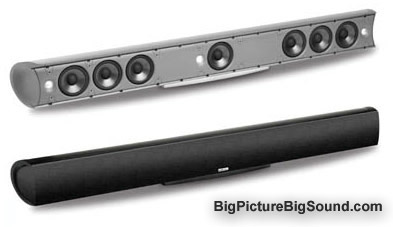
The SurroundBar comes in titanium and black to match most flat panel televisions (titanium version shown with grille removed).
How do they do it? Well getting into all the details would probably make your eyes glaze over (it did mine), but two things primarily come into play - targeted phase cancellation widens the soundstage (so the front left and right speakers sound further apart than they really are), and "Head Related Transfer Functions" (HRTFs) are used to make rear channel sounds seem as if they are coming from behind you.
The theory behind HRTF is that our brain determines front to back direction of sound based on tiny differences in the time it takes these sound to reach our ears, combined with the way our ear shape and orientation affects the frequency response of incoming sounds. If you delay a sound just the right amount, and adjust its frequency blend so it matches the way it sounds when it originates behind your head, then you can theoretically simulate rear-channel sound from a speaker that's actually in front of you. So does it work? Yes... and no.
The Set-Up
Setting up the SurroundBar was simple - use the included 25 foot color-coded cable (or your own cables) to connect the five speaker outputs from your receiver (left, right, center, left surround, right surround) to the corresponding inputs on the Surround Bar, place it on its included stand in front of your TV, connect a subwoofer to your receiver's subwoofer out, and adjust the levels.
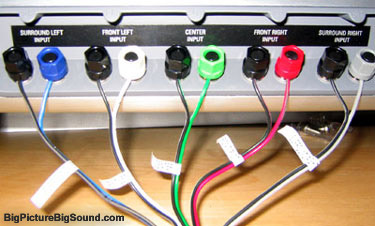
Clear labelling and color coded wires make hook-up a snap (photo by Marcelo Borges).
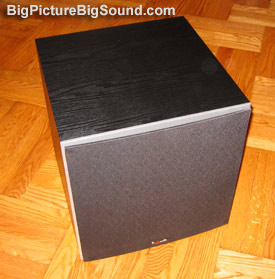
Polk's PSW10 Subwoofer makes an excellent match for the SurroundBar.
The SurroundBar comes with a wall bracket and table stand, so if your television is sitting on a stand or entertainment center, and there's room in front, then placing the SurroundBar immediately below the TV is your best bet. If you have a flat panel TV mounted on the wall (or a front projection system projecting on a wall or screen) then you can mount the SurroundBar above or below the screen, but with experimentation, I found placement below the screen to sound better than above. The closer you can get to ear level, the better.
Polk suggests that you set up the subwoofer via the speaker level outputs of your receiver, instead of the line level subwoofer output, but I was able to get a balanced blend with the subwoofer hooked up to the line output. Your mileage may vary of course. Try it both ways and stick with whichever configuration sounds best to you.
One thing I do recommend highly is to follow the set-up advice that comes with the SurroundBar, in terms of setting the rear channel levels. Do not bother using a receiver's auto-calibration features (assuming yours has one), as these systems are not really compatible with one-box surround speakers. Calibrate the levels instead with a Radio Shack SPL meter. And once the levels are "right" (equal SPL readings from each channel), then crank up the rear channels an additional few decibels higher. In my final settings, on an Onkyo home theater receiver, I ended up with the front channels set at 0 and the rear channels at +6 in order to get the best effect. In the end, listen to material with which you're familiar, and set the levels however they sound best to you.
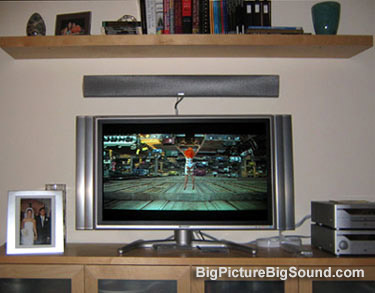
The SurroundBar can be placed above or below any display, but placement close to ear height gives you the best surround effect (photo by Marcelo Borges).
Listening
The SurroundBar probably creates as convincing an illusion of surround sound as you can get from a single box speaker. If you close your eyes (or even keep them open), listen to the right material, and have the system calibrated just so, you really can be fooled into thinking that sound is coming from behind you, at least on certain material. I noticed this most with the surround sound test tones that come with every home theater receiver. The test tones from the rear channels really seem to be behind you when the receiver cycles through to the rear.
But since most people don't sit around listening to test tones, I'm happy to report that certain movie and video tracks had similar results. Specifically the intro to the "Adrenaline Rush" base-jumping segment on the DTS "Alive!" sampler disc created some truly believable rear channel sounds. Also, the pod race scene from "Star Wars: Episode I" was captured by the SurroundBar in a reasonable approximation of surround sound goodness, with spinning pod racer parts whizzing by over my head. And the sound on Baz Luhrmann's "Moulin Rouge" was so compelling that the film was half over before I remembered that I was listening to a single box speaker. And that's probably the feature that impressed me most about the unit. It's a very satisfying and involving system that will not leave you wanting more.
The width of the SurroundBar image is unreal - definitely a great deal wider than the cabinet's physical dimensions would seem to support. And the frequency blend of the system speaks for the quality of the drivers. The sound was never thin or nasally, nor was it fat or bloated. Voices and acoustic instruments sounded natural and pleasing to the ear. I mated the system with a Polk PSW10 subwoofer and the blend between the woofer and the Surround Bar was seamless with no frequency bumps in the wrong places.
I tested the Surround Bar out with standard stereo music (with no processing modes engaged on the receiver) and it sounded nice and balanced - male vocals were full without being throaty and electric guitars were meaty and crisp. In this mode, the SurroundBar's "surround magic" is not engaged, as only the left and right speakers within the bar are being driven. But then switching the receiver over to Dolby Pro Logic II Music mode (allowing the SurroundBar to stretch its virtual surround legs) really opened up the sound stage, similar to a discrete 5.1-channel system. The musicians' placement around the room expanded to take up the front half of the room, while ambience from the recording provided a sense of space more reminiscent of a live concert.
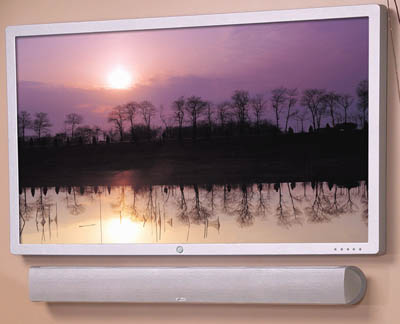
The SurroundBar's slim design will complement any flat panel television
Final Thoughts
To get sound that truly emanates from behind you, you need speakers behind you. But if this is simply not an option, then the SurroundBar will get you about as close to discrete surround sound as you can get from a single-box speaker at the front of the room. And its sound quality speaks of its heritage - the Polk speakers sound rich and full-balanced and will blow away the speakers built into any television, flat panel or otherwise. You'll want to add a subwoofer, of course - a box this small simply can't put out prodigious amounts of low bass.
At an MSRP of $949, the system is a bit pricy, particularly considering it has no built in amplification, so you still need a surround sound receiver to drive it. But when you consider that people are happily plunking down $2,000, $3,000 or more on a flat-panel TV, spending half that to take care of the audio portion doesn't seem completely out-of-line. If you want a taste of surround with a sleek single speaker, then the Polk SurroundBar is worth a look, and a listen.
Where to Buy:
Manufacturer's Specifications:
Driver Complement:
- Midrange (7) - 3-1/2" Diameter (8.89cm)
- Tweeter (3) - 3/4" Diameter (1.91cm) - Silk/Polymer composite dome
Electrical:
- Lower -3dB Limit 100 Hz
- Upper -3dB Limit 20 kHz
- Nominal Impedance 8 ohms
- Recommended Amplifier Power 20 - 125 w/channel
- Efficiency 89 dB
Dimensions and Options
- 4-7/16" H x 42-5/8" W x 5-1/8" D (11.27cm H x 108.27cm W x 13.02cm D)
- Weight: 25.00 lbs. (11.34kgs)
- Color: Black or Titanium
Warranty
- 5 years parts and labor (original purchaser)
What's in the Box?
- SurroundBar
- 2 piece wall bracket
- Center channel base
- 25' wire bundle
- Quick Start Guide
Manufacturer's Contact Information:
Polk Audio
5601 Metro Drive
Baltimore, MD 21215
Main Phone: 410-358-3600
Toll Free: 800-377-7655
Email: web form
Web: www.polkaudio.com




